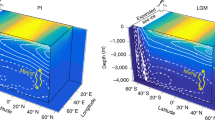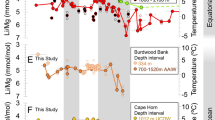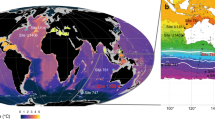Abstract
The CLIMAP1 project's reconstruction of past sea surface temperature inferred limited ice-age cooling in the tropical oceans. This conclusion has been controversial, however, because of the greater cooling indicated by other terrestrial and ocean proxy data2,3,4,5,6. A new faunal sea surface temperature reconstruction, calibrated using the variation of foraminiferal species through time, better represents ice-age faunal assemblages and so reveals greater cooling than CLIMAP in the equatorial current systems of the eastern Pacific and tropical Atlantic oceans7. Here we explore the climatic implications of this revised sea surface temperature field for the Last Glacial Maximum using an atmospheric general circulation model. Relative to model results obtained using CLIMAP sea surface temperatures, the cooler equatorial oceans modify seasonal air temperatures by 1–2 °C or more across parts of South America, Africa and southeast Asia and cause attendant changes in regional moisture patterns. In our simulation of the Last Glacial Maximum, the Amazon lowlands, for example, are cooler and drier, whereas the Andean highlands are cooler and wetter than the control simulation. Our results may help to resolve some of the apparent disagreements between oceanic and continental proxy climate data. Moreover, they suggest a wind-related mechanism for enhancing the export of water vapour from the Atlantic to the Indo–Pacific oceans, which may link variations in deep-water production and high-latitude climate changes to equatorial sea surface temperatures.
This is a preview of subscription content, access via your institution
Access options
Subscribe to this journal
Receive 51 print issues and online access
$199.00 per year
only $3.90 per issue
Buy this article
- Purchase on Springer Link
- Instant access to full article PDF
Prices may be subject to local taxes which are calculated during checkout


Similar content being viewed by others
References
CLIMAP Project Members.Seasonal reconstruction of the earth's surface at the last glacial maximum.(Map & Chart Ser. MC-3,Geol. Soc. Am., Boulder, Colorad, 1981).
Thompson, L. G. et al. . Late glacial stage and Holocene tropical ice core records from Huascaran, Peru. Science 269, 46–50 (1995).
Stute, M. et al. . Cooling of tropical Brazil (5° C) during the last glacial maximum. Science 269, 379–383 (1995).
Stute, M. et al. . Glacial paleotemperature records for the tropics derived from noble gases dissolved in groundwater (abstr). Eos 78, F44 (1997).
Guilderson, T. P., Fairbanks, R. G. & Rubenstone, J. L. Tropical temperature variations since 20,000 years ago: modulating interhemispheric climate change. Science 263, 663–665 (1994).
Rind, D. & Peteet, D. Terrestrial conditions at the last glacial maximum and CLIMAP sea-surface temperature estimates: are they consistent? Quat. Res. 24, 1–22 (1985).
Mix, A. C., Morey, A., Pisias, N. G. & Hostetler, S. Foraminiferal faunal estimates of paleotemperature: Circumventing the no-analog problem yields cool ice age tropics. Paleoceanography 14, 350–359 (1999).
Slowey, N. & Curry, W. B. Glacial-interglacial differences in circulation and carbon cycling within the upper western North Atlantic. Paleoceanography 10, 715–732 (1995).
Ganopolski, A., Rahmstorf, S., Petoukhov, V. & Claussen, M. Simulation of modern and glacial climates with a coupled global model of intermediate complexity. Nature 391, 351–356 (1998).
Thompson, S. L. & Pollard, D. Aglobal climate model (GENESIS) with a land-surface-transfer scheme (LSX), 1, present-day climate. J. Clim. 8, 732–761 (1995).
Dorman, J. L. & Sellers, P. J. Aglobal climatology of albedo, roughness length, and stomatal resistance for atmospheric general circulation models as represented by the simple biosphere model (SiB). J. Appl. Meteorol. 28, 833–855 (1989).
Clark, P. U., Licciardi, J. M., MacAyeal, D. R. & Jenson, J. W. Numerical reconstruction of a soft-bedded Laurentide ice sheet during the last glacial maximum. Geology 24, 679–682 (1996).
Peltier, W. R. Ice age paleotopography. Science 265, 195–201 (1994).
Thunell, R. C., Anderson, D. M., Gellar, D. & Miao, Q. Sea-surface temperature estimates for the tropical western Pacific during the last glaciation and their implications for the Pacific warm pool. Quat. Res. 41, 255–264 (1994).
Prell, W. L. & Kutzbach, J. E. Monsoon variability over the past 150,000 years. J. Geophys. Res. 92, 8411–8425 (1987).
Markgraf, V. in Global Climates Since the Last Glacial Maximum(eds Wright, H. E. et al.) 357–385 (Univ. Minnesota Press, Minneapolis, 1993).
Zaucker, F. & Broecker, W. S. The influence of atmospheric moisture transport on the fresh water balance of the Atlantic drainage basin: General circulation model simulations and observations. J. Geophys. Res. 97, 2765–2773 (1992).
Zaucker, F., Stocker, T. F. & Broecker, W. S. Atmospheric freshwater fluxes and their effect on the global thermohaline circulation. J. Geophys. Res. 99, 12443–12457 (1994).
Servant, M. et al. . Tropical forest changes during the late Quaternary in African and South American lowlands. Glob. Planet. Change 7, 25–40 (1993).
Klein, A. G., Seltzer, G. O. & Isacks, B. L. Modern and last local glacial maximum snowlines in the Central Andes of Peru, Bolivia, and Northern Chile. Quat. Sci. Rev. 18, 63–84 (1999).
Downie, C. & Wilkinson, P. The Geology of Kilimanjaro(Univ. Sheffield Press, 1972).
Löffler, E. Pleistocene glaciation in Papua and New Guinea. Z. Geomorphol. 13, 32–58 (1972).
Porter, S. C. Chronology of Hawaiian glaciations. Science 195, 61–63 (1977).
Lee, K. E. & Slowey, N. C. Cool surface waters of the subtropical North Pacific Ocean during the last glacial. Nature 397, 512–514 (1999).
Crowley, T. J. & Baum, S. K. Effect of vegetation on an ice-age climate model simulation. J. Geophys. Res. 102, 16463–16480 (1997).
Farrera, I. et al. . Tropical climates at the last glacial maximum: A new synthesis of terrestrial palaeoclimate data, I, Vegetation, lake levels, and geochemistry. Clim. Dyn.(in the press).
Bush, A. B. G. & Philander, S. G. H. The role of ocean-atmosphere interactions in tropical cooling during the last glacial maximum. Science 279, 1341–1344 (1998).
Weaver, A. J., Eby, M., Fanning, A. F. & Wiebe, E. C. Simulated influence of carbon dioxide, orbital forcing, and ice sheets on the climate of the last glacial maximum. Nature 394, 847–853 (1998).
Bigg, G. R., Wadley, M. R., Stevens, D. P. & Johnson, J. A. Simulation of two last glacial maximum ocean states. Paleoceanography 13, 340–351 (1998).
Chervin, R. M. Interannual variability and seasonal predictability. J. Atmos. Sci. 43, 233–241 (1986).
Acknowledgements
We thank P. Bartlein for discussions and the design of Fig. 2; P. Clark, N. Pisias, D.Pollard for discussions; P. Valdez for comments and suggestions; and A. Morey and D. Zahnle for assistance. Model simulations were conducted at the National Center for Atmospheric Research, the Environmental Protection Agency, and the College of Oceanic and Atmospheric Sciences at Oregon State University. The US Geological Survey (S.W.H.) and The National Science Foundation (A.C.M.) supported this research.
Author information
Authors and Affiliations
Corresponding author
Rights and permissions
About this article
Cite this article
Hostetler, S., Mix, A. Reassessment of ice-age cooling of the tropical ocean and atmosphere. Nature 399, 673–676 (1999). https://doi.org/10.1038/21401
Received:
Accepted:
Issue Date:
DOI: https://doi.org/10.1038/21401
This article is cited by
-
Moisture transport across Central America as a positive feedback on abrupt climatic changes
Nature (2007)
-
Historical perspectives on population genetics and conservation of three marine turtle species
Conservation Genetics (2005)
-
Surface temperature control in the North and tropical Pacific during the last glacial maximum
Climate Dynamics (2004)
-
Tropical climate changes at millennial and orbital timescales on the Bolivian Altiplano
Nature (2001)
Comments
By submitting a comment you agree to abide by our Terms and Community Guidelines. If you find something abusive or that does not comply with our terms or guidelines please flag it as inappropriate.



